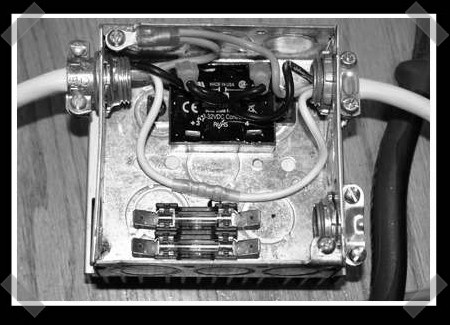
[toymotorhead] pieced together this USB controlled power strip to help with his electrical bill. His goal was to be able to have devices turned off automatically when he shut down his computer as well as powered on when he turned his computer on. Another requirement was that the USB be isolated to protect the motherboard from spikes.
The cost of the parts in total were less than $30, and consisted of a solid state relay, some fuses, and some transient voltage surge suppressing diodes. The unit only switches power off or on depending on whether or not the computer is powered up, it doesn’t control the outlets via software. He goes pretty in depth as to how everything works as well as showing nice diagrams and pictures. This should be a fairly quick and simple project, as long as you take the proper precautions for working with high voltage.















Does anyone know how much these cost to buy ‘retail’? My friend had one, to turn on his RAID power supply when the computer came on. Was just a USB cable, with male A at one end, and a male and female electrical pass-thru on the other.
Fuses and transient protection diodes don’t provide isolation, they’re just protection. The only isolation in this circuit is in the relay itself.
I created something similar using a timer socket (the ones that let you set a time for a light to come on etc) for the relay and a usb cable hooked up to an opto isolator connected to control circuit on the pcb total cost < £10 (+ a 4 way).
Its not a solid state relay but it works well enough.
This can be done for about $10 or less.
Use the usb cable to power an optoisolator that controls
a ac-dc converter that powers the relay.
only 4 parts needed.
Optoisolator
AC-DC converter
Relay
Diode
Totally isolated from the pc .
Or if you don’t care about isolation.
A relay and diode+usb cable is all that is needed.
why is it old computers had a power connector for this purpose, which only leads energy while the computer is running, and nowadays, no one provides this feature?
My usb ports provide continual power if the computer has been shut down using the operating system. To stop power from going to the usb ports I have to flip the power switch on the power supply.
@diy audio projects: some motherboards have a jumper to select what you want it or failing that you could hook it up to the 5v rail on your computers power supply. That should be off when the computers off ;).
Why not just use a mechanical relay? A 6V relay works fine with 5V in my experience.
Costs $30 for a whole power strip that works the same way off USB, but they are currently out of stock:
http://www.theecostrip.com/index.html
I have been working on a “real” USB device similar to this – i.e. with the computer actually able to control each outlet. The idea is to allow me to turn my printer on and off without having to reach around it all the time.
It’s fairly simple to do with an AVR microcontroller, so I am adding an IR interface to it as an extra feature.
anything less than 500volts is actually low voltage
I have this site bookmarked. Thanks from Kredit